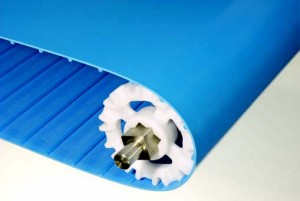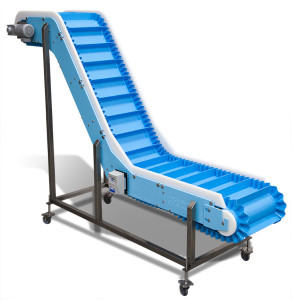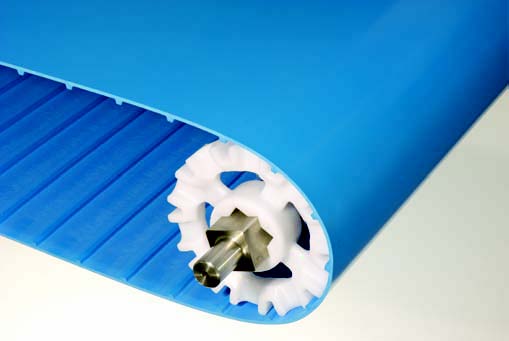 Polyurethane tensionless conveyor belts have revolutionized the sanitary conveyor industry. Being involved with the design and manufacture of conveyors for the last 20+ years, I have seen continuous design improvements relative to sanitary conveyors. Motors, drives, sidewall design and support systems have incrementally improved through the years. However, there is one technology that has forever changed the way sanitary conveyors are designed. That technology is in the polyurethane tensionless conveyor belting.
Polyurethane tensionless conveyor belts have revolutionized the sanitary conveyor industry. Being involved with the design and manufacture of conveyors for the last 20+ years, I have seen continuous design improvements relative to sanitary conveyors. Motors, drives, sidewall design and support systems have incrementally improved through the years. However, there is one technology that has forever changed the way sanitary conveyors are designed. That technology is in the polyurethane tensionless conveyor belting.
Twenty years ago there were two types of belts used: rubber belts and plastic link style belts. Rubber belts had to be tensioned, so reinforcing steel or fabric cords were incorporated into the middle of the belt. If these cords were exposed they became harborage points for bacteria. Additionally, because the belts needed tension to operate, side to side tracking problems often became an ongoing maintenance issue.
The most popular belt during that time was a plastic, link style, modular belt. These belts had an open hinge making them easier to clean, but they were still extremely time consuming to clean. It was nearly impossible to guarantee that every one of the thousands of hinges, in a single belt, was properly cleaned and sanitized. Additionally, these belts are very heavy and hard to put on and take off the conveyor.
 About ten years ago a noticeable, major belt revolution began. Polyurethane tensionless conveyor belts were introduced and have solved almost all of the problems associated with food conveyance. Benefits of the patented tensionless belt system are:
About ten years ago a noticeable, major belt revolution began. Polyurethane tensionless conveyor belts were introduced and have solved almost all of the problems associated with food conveyance. Benefits of the patented tensionless belt system are:
- Light-weight: the belts can be easily lifted for cleaning while still on the conveyor. The ability for cleaning in place saves time and money.
- Homogeneous: every square inch of the belt is solid and of the same chemistry. Even if the belt gets a slight nick or gouge in it, it will not generate any bacterial harborage points.
- Sprocket Driven: designed to run tensionless, which eliminates all costly tracking issues.
- Continuous Development: The chemistry of Polyurethane tensionless conveyor belts continues to change. These modifications allow the belts to be used in extreme conditions which include high or low temperatures, extreme load and high impact. The surface treatments of these belts continues to evolve as well. Recent developments have eliminated the issues associated with conveying foods that are sticky, fatty, heavy, hot or cold.
Polyurethane tensionless conveyor belt technology, partnered with an easy-to-clean sanitary conveyor design, will save you a substantial amount of money in three specific categories:
- Your cleaning costs can get cut in half
- Your conveyor downtime will be reduced by eliminating tracking issues
- Elimination of bacterial harborage points will substantially reduce the likelihood of recall issues
It has been enjoyable to use this game changing belt technology when designing sanitary conveyors for the food processing industry.
[btn url=”https://dynamicconveyor.com/contact”] Contact Us About Your Needs Today [/btn]- Buy a Conveyor or Not: When is it Time to Buy a Conveyor? - December 6, 2022
- Dynamic Conveyor Introduces New Modular, Powered Roller Conveyor for End of Line Solution in Manufacturing - May 20, 2022
- How to Reduce Conveyor Maintenance Costs - September 30, 2020


